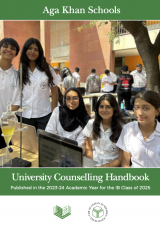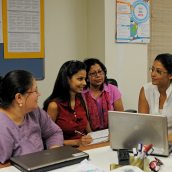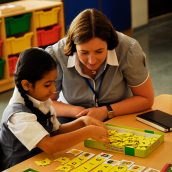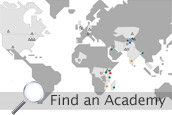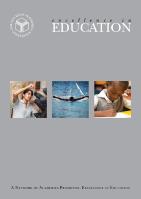Building the Academies network: The Aga Khan Academies launch their first teacher exchange
When she sat down with Rukiya, the Primary Years Programme Coordinator at Mombasa, they started piecing together an idea that would bring the two schools, which are the first of a growing network of Academies, closer together.
“It was really exciting to have a conversation with a colleague from another Academy,” recalled Rukiya. “We started thinking and talking about how we could make the network vision a reality. That was when we first discussed having teachers visit the different schools.”
Bringing the exchange to life
Within months, Rukiya and Sreelatha’s project came to life. The first teacher exchange took place between September and November 2014. Two teachers – one Kenyan and one Indian – swapped classes for two months. In the process, they learned new ways to manage their classrooms, bonded with children from another continent and explored ways to improve their teaching with their foreign peers.
The Aga Khan Academies have been designed to foster cross-cultural learning and to share best practices across schools. “The schools that constitute this network are not a loose constellation of like-minded institutions, but rather an integrated learning community,” explained Salim Bhatia, Director of the Academies, at the foundation-stone laying ceremony for the Aga Khan Academy Kampala in 2007.
By bringing teachers from different cultures together with students, the teacher exchange programme works towards His Highness’s vision of a network of Academies that foster creativity, curiosity and inquiry rooted in “a pluralistic tradition in which other views, ethnicities, religions and perspectives are valued.”
Although teachers across the Academies network teach within widely different cultural, historical and geographic contexts, the common International Baccalaureate (IB) curriculum framework and the shared vision and mission of the Academies make it easy for the schools to collaborate, explained Sreelatha.
Evelyn preparing her grade 4 class for the teacher exchange With this in mind, Evelyn Awino, a grade 4 teacher from Mombasa, and Sheherbanoo Fathi, a grade 5 teacher from Hyderabad, found themselves crossing continents and trading classes in September 2014.Evelyn started teaching just two days after she landed in Hyderabad, but, she says, being thrown into the deep end made her experience especially enriching. “It was good to be in a position where I felt I didn’t know,” she recalled. “That helped me to learn what to do with children when they are new in my class. I got into the shoes of a new student and thought about what I can do as a new teacher to make them feel at home.”
Sharing best practices across schools
Evelyn chose to go to Hyderabad because the school’s teachers have diverse experience teaching the Primary Years Programme (PYP), a curriculum for students between 3 and 12 years in IB schools. While the teachers in Mombasa obtained IB training specifically so they could teach at the Academy – the only IB World School in the city – those in Hyderabad have taught IB at many other schools.
By observing and speaking with the teachers in Hyderabad, Evelyn was able to enhance her ability to use one of the main teaching strategies of the PYP approach – the inquiry cycle. In this approach, students explore a topic through identifying questions, testing hypotheses and reflecting on the process. The teachers at Hyderabad helped Evelyn expand her toolbox by sharing different ways to implement the inquiry method.
“I used to have so much ownership of the learning and the direction that a lesson leads, but I learned to let go,” explained Evelyn. Now she employs strategies in which the children take charge of the learning process more frequently than before.
“Right now we are working on a history-based unit in Mombasa. So I worked with the kids to develop the criteria for grading their assessment,” she explained. “For their assignment, each child is doing some research on the history of a specific place or landmark, such as a famous local bridge, a railway line or the Academy itself. I asked them: What is it that we need to see? What is it that you know? How do we know that this place is a place of history? What evidence will you give me?”
While Evelyn was busy learning new techniques to apply the inquiry method in her classroom, Sheherbanoo, who has nearly nine years of experience as a PYP teacher, was busy sharing her knowledge with teachers in Mombasa. She ran sessions for teachers interested in learning about different approaches for organising PYP classes. The teachers at Mombasa also had a chance to see Sheherbanoo in action and receive feedback from her on their own teaching. They’ve since started their own social network to continue the learning process, discuss challenges and share teaching strategies.
Both teachers saw things to improve in the Academies they visited, as well as things they could take away. Evelyn started a reading programme in Hyderabad. “I wanted to get the students to love reading and get them hooked on reading every day,” she explained.
Meanwhile, Sheherbanoo organised an end-of-unit assembly for her students and returned to Hyderabad with thoughts on how to improve communication in her own Academy. “I loved the fact that every Wednesday morning, the teachers in Mombasa would get together before school started and share an activity that worked well in the class,” she said. “That is something we’re planning to implement over here.”
“I also liked the level of collaboration between the Senior and Junior Schools in Mombasa. In Hyderabad, we’re quite separated, but, in Mombasa, they have combined professional development sessions between the Junior and Senior School teachers,” she added.
Learning from another culture
Even as they are imbued with an international outlook, the Academies are also strongly rooted in the places where they are built. “A key tenant of His Highness’s vision is that local teachers will form the majority of each Academy’s staff,” said Alexandra Holland, Curriculum Development Manager for the Aga Khan Academies.“Many of these teachers have not had the chance to travel widely, so a teacher exchange allows them to experience working in a country other than their own for an extended period of time,” she continued. ”Living and working alongside colleagues with different backgrounds, experiences and assumptions gives our teachers a first-hand experience of the challenges and rewards of a pluralistic disposition, which they can bring back to their home schools.”
For the students, the teacher exchange is an opportunity to gain international exposure and interact with someone from another culture.
“There were just two African people in Hyderabad – another student and I,” recalled Evelyn. “I helped the students to understand the difference between African and Kenyan – and how we have so many different cultures, even within Kenya itself.”
Meanwhile, Sheherbanoo bonded with her Mombasa colleagues and had a cross-cultural exchange with students during an overnight trip to Watamu, where they learned about turtle conservation and went stargazing. And both teachers had an opportunity to get to know the people of a country they’d previously only dreamed about.
“The experience of meeting people in India helped me to make connections between what I had imagined, read and heard about, and the reality on the ground,” Evelyn said.
With the exchange programme set to expand and ultimately include Senior School teachers and students, Evelyn and Sheherbanoo are just the first of many that will be given opportunities to enhance their skills through cross-cultural learning.
“We want our teachers and students, wherever they are based in the world, to have the opportunity to learn collaboratively with one another,” Alexandra explained. “The exchange was a further step in the process of building this integrated, collaborative learning community.”
By Alia Dharssi
Newsletter readers please click here to return to the newsletter (browser version)
publications
